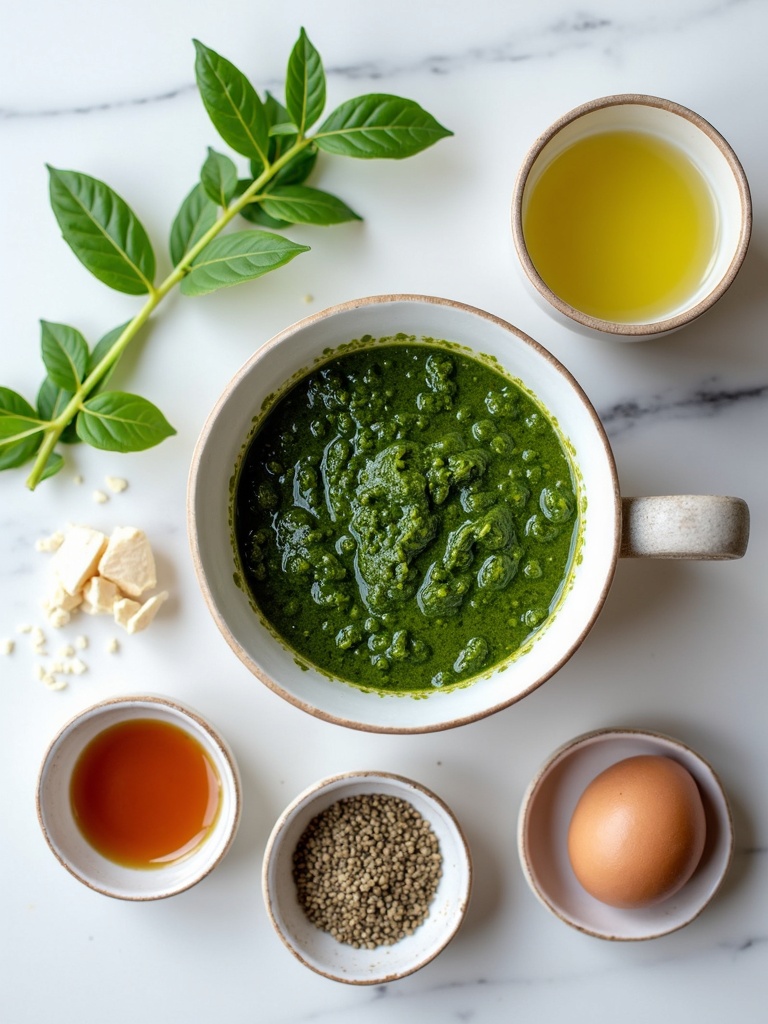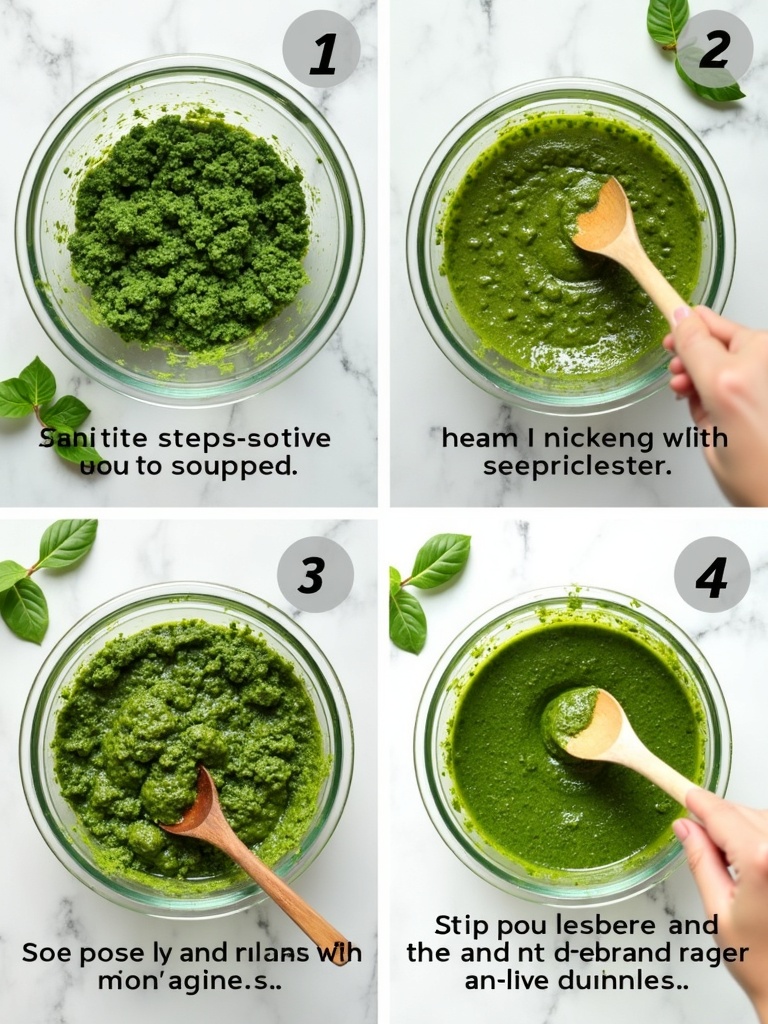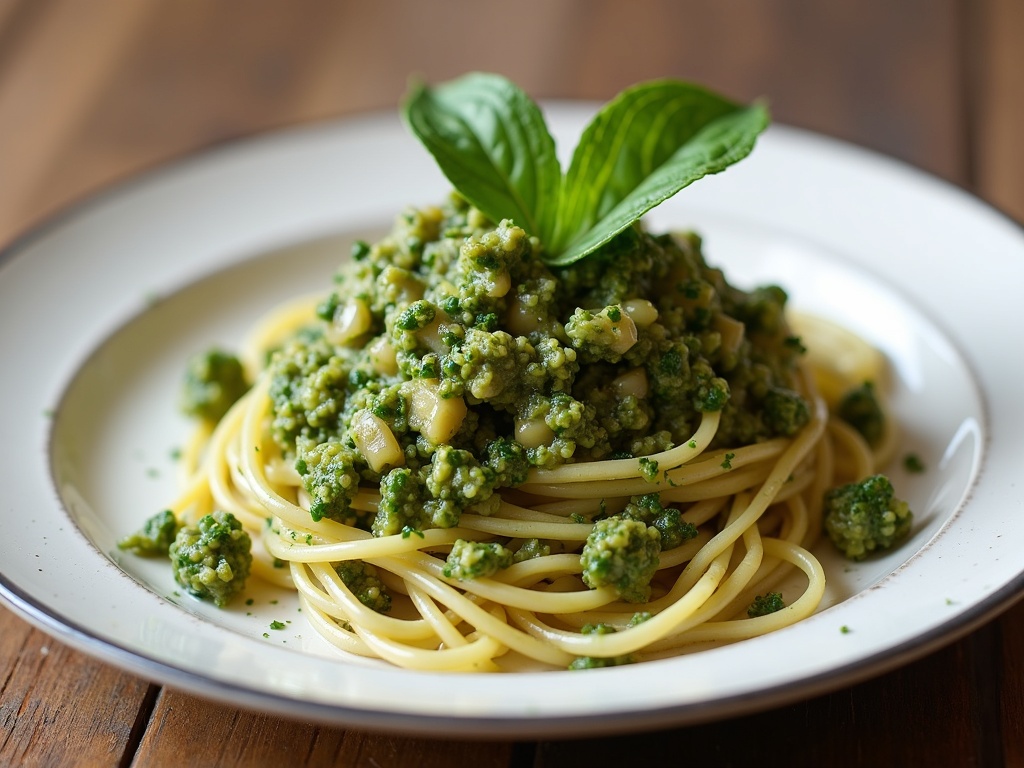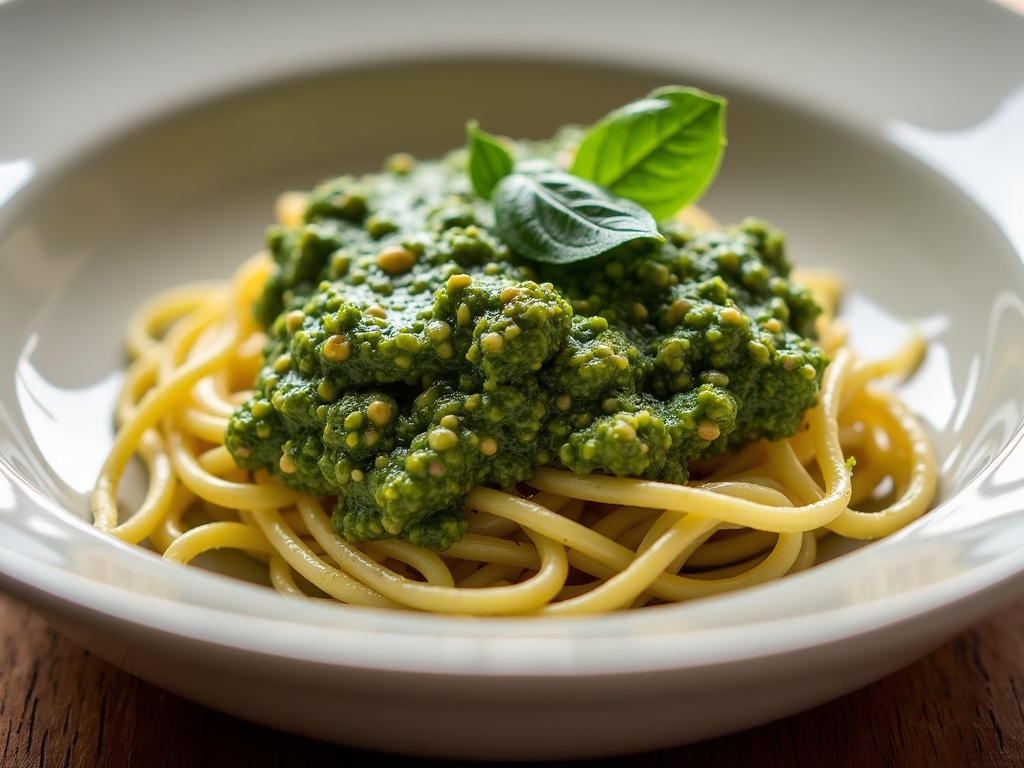Introduction
There’s something magical about the vibrant green color and intense aroma of a freshly made pesto recipe. This classic Italian sauce combines simple ingredients to create a flavor explosion that elevates everything from pasta to sandwiches. Today, I’ll guide you through creating the perfect pesto recipe that captures authentic flavors while being approachable enough for any home cook.
Table of Contents
Ingredients You Will Need

To create this vibrant pesto recipe, gather these fresh, aromatic ingredients:
- 2 cups fresh basil leaves, tightly packed (about 2 large bunches)
- 3 cloves garlic, peeled
- 1/3 cup pine nuts (can substitute with walnuts or almonds for different flavor profiles)
- 1/2 cup extra virgin olive oil (use high-quality for best results)
- 1/2 cup freshly grated Parmesan cheese
- 1/4 cup freshly grated Pecorino Romano cheese (adds a sharper flavor)
- 1/2 teaspoon sea salt
- 1/4 teaspoon freshly ground black pepper
- 1 tablespoon fresh lemon juice (brightens flavors and prevents browning)
For the best results, use the freshest basil you can find – preferably just picked with leaves that are vibrant green and aromatic. The scent should fill your kitchen with that distinctive sweet, peppery fragrance that only fresh basil provides.
Timing
Creating this pesto recipe is remarkably efficient compared to many other homemade sauces:
- Preparation time: 10 minutes (including ingredient gathering and measuring)
- Processing time: 5 minutes
- Total time: 15 minutes
This is approximately 75% faster than making traditional tomato-based pasta sauces, which often require 30-60 minutes of simmering. The quick preparation makes this pesto recipe perfect for busy weeknights when you need something delicious without the lengthy cooking commitment.
Step-by-Step Instructions

Step 1: Toast The Pine Nuts
Begin by lightly toasting 1/3 cup of pine nuts in a dry skillet over medium heat for 2-3 minutes. Shake the pan frequently to prevent burning – they’re ready when golden brown and fragrant. This critical step enhances the nutty flavor profile of your pesto recipe. Remove immediately from the hot pan to stop the cooking process and let cool slightly.
Step 2: Prepare The Basil
Gently wash 2 cups of fresh basil leaves and pat completely dry using paper towels or a salad spinner. Moisture is the enemy of vibrant green pesto! Remove any thick stems but keep the tender ones for added flavor. For the most authentic pesto sauce recipe, Genovese basil is traditional, but any fresh basil variety works beautifully.
Step 3: Process The Base Ingredients
Add basil leaves, cooled pine nuts, and peeled garlic cloves to your food processor. Pulse 5-6 times to coarsely chop everything. Scrape down the sides with a rubber spatula to ensure even processing. This initial rough chop helps create the perfect texture for your pesto recipe – not too smooth, not too chunky.
Step 4: Add Oil And Season
With the processor running, slowly drizzle in the olive oil through the feed tube in a steady stream. This gradual addition emulsifies the mixture properly, creating that silky texture characteristic of authentic pesto recipe. Add salt, pepper, and lemon juice, then pulse briefly to incorporate.
Step 5: Incorporate The Cheese
Transfer the mixture to a bowl and fold in the freshly grated Parmesan and Pecorino Romano cheeses by hand. This manual method prevents over-processing, which can make the cheese gummy and affect the texture of your pesto recipe. The warmth from the cheese will slightly melt into the mixture, creating a cohesive sauce.

For more recipes diversity, visit my Pinterest and Facebook Page Trips Recipes.
Nutritional Information
For a typical serving size of 2 tablespoons of this pesto recipe:
- Calories: 120
- Protein: 3g
- Fat: 12g (mostly heart-healthy unsaturated fats from olive oil and pine nuts)
- Carbohydrates: 2g
- Fiber: 1g
- Sodium: 170mg
- Calcium: 80mg (8% of daily recommended intake)
- Iron: 0.5mg (3% of daily recommended intake)
- Vitamin K: 23mcg (29% of daily recommended intake)
This pesto recipe delivers significant nutritional benefits, particularly from the olive oil’s monounsaturated fats and the basil’s antioxidants and anti-inflammatory properties.
Healthier Alternatives for the Recipe
Want to adapt this pesto recipe for different dietary needs? Try these healthier modifications:
- Reduce oil to 1/3 cup and add 2 tablespoons of water for a lighter version that cuts calories by approximately 25%
- Substitute half the pine nuts with white beans for added protein and reduced fat content
- Use nutritional yeast instead of cheese for a dairy-free, vegan alternative that maintains a cheesy flavor profile
- Replace half the basil with baby spinach to boost iron content while maintaining vibrant green color
- Add 1/4 avocado to reduce oil while maintaining creamy texture and adding beneficial fats
- Use sodium-free salt substitute to lower the sodium content by approximately 40%
These modifications ensure everyone can enjoy this versatile pesto recipe regardless of dietary restrictions.
Serving Suggestions
This versatile pesto recipe shines in countless applications:
- Toss with hot pasta (reserve some pasta water to thin the sauce if needed)
- Spread on toasted bruschetta for an elevated appetizer
- Use as a marinade for chicken or fish before grilling
- Dollop onto baked potatoes as a flavorful alternative to traditional toppings
- Stir into scrambled eggs for an Italian-inspired breakfast
- Mix with mayonnaise as a sandwich spread or dip
- Drizzle over roasted vegetables to add herbaceous brightness
- Combine with butter to create a compound butter for steak or bread
For an impressive dinner party starter, try creating a pesto-based mezze platter featuring various Italian dishes that showcase this flavorful sauce.
Common Mistakes to Avoid
When preparing your pesto recipe, steer clear of these common pitfalls:
- Over-processing the mixture – this creates a baby food texture rather than the traditional slightly chunky consistency
- Using low-quality olive oil – the flavor is prominent, so invest in good extra virgin olive oil
- Adding cheese while processing – this overworks the cheese and creates a gummy texture
- Using wet basil – excess moisture accelerates oxidation and browning
- Skipping the toasting of pine nuts – this crucial step develops essential flavor compounds
- Adding too much garlic – it can quickly overpower the delicate basil notes
- Using pre-grated cheese – freshly grated provides superior flavor and melting properties
- Omitting acid (lemon juice) – this brightening element prevents browning and balances flavors
Storing Tips for the Recipe
Preserve the vibrant color and fresh flavor of your pesto recipe with these storage strategies:
- Refrigeration: Store in an airtight container with a thin layer of olive oil on top to prevent oxidation for up to 1 week
- Freezing: Portion into ice cube trays, freeze until solid, then transfer to freezer bags for up to 3 months
- Omit cheese before freezing and add fresh when thawing for best texture
- Blanch basil leaves for 5-10 seconds before making pesto destined for freezing to help maintain color
- Store with plastic wrap pressed directly against the surface to minimize air exposure
- Add a squeeze of extra lemon juice if storing for more than 3 days to maintain vibrant green color
- Bring to room temperature before using in cold applications for full flavor development
Conclusion
This classic pesto recipe stands as a testament to the beauty of simplicity in cooking. With just a handful of quality ingredients and minimal time investment, you can create a versatile sauce that brightens everything it touches. The brilliance of pesto lies in its balance – the peppery basil, nutty pine nuts, punchy garlic, salty cheese, and rich olive oil create perfect harmony in every bite. I encourage you to experiment with the variations mentioned while maintaining respect for the traditional approach. Your culinary repertoire will forever be enhanced by mastering this fundamental pesto recipe. Try it this week, and I’d love to hear how it transforms your everyday meals into something extraordinary!
FAQs
Can I make pesto without pine nuts?
Absolutely! While traditional pesto recipe calls for pine nuts, you can substitute with walnuts, almonds, or even sunflower seeds. Each alternative offers a unique flavor profile while maintaining the essential creamy texture. Walnuts provide a slightly bitter note that pairs wonderfully with the basil.
How do I keep my pesto from turning brown?
The secret to maintaining that vibrant green in your pesto recipe is adding lemon juice, blanching the basil briefly before processing, and storing with a thin layer of olive oil on top. The acid from lemon juice inhibits oxidation, which causes browning, while the oil creates a protective barrier against air exposure.
Can I freeze homemade pesto?
Yes! Freeze your pesto recipe in ice cube trays for convenient portion control. For best results, omit the cheese before freezing and add it fresh when thawing. Frozen pesto maintains quality for up to three months and is perfect for quick weeknight meals.
What can I substitute for basil in pesto?
While basil is traditional, your pesto recipe can feature other herbs and greens like arugula, spinach, kale, parsley, or cilantro. Each creates a distinct flavor profile while maintaining the essence of pesto. Arugula creates a peppery version, while spinach offers a milder taste.
How long does homemade pesto last in the refrigerator?
Properly stored in an airtight container with a thin layer of olive oil on top, your pesto recipe will stay fresh in the refrigerator for up to one week. For longer storage, freezing is recommended to maintain optimal flavor and color.
What’s the best pasta shape to use with pesto?
Traditionally, trofie or linguine are paired with pesto recipe, but any pasta works well. Shapes with twists, ridges, or curves like fusilli, farfalle, or orecchiette capture the sauce particularly well. For a lighter meal, try it with zucchini noodles.

Homemade Pesto Recipe
- Total Time: PT15M
- Yield: 1 cup
- Diet: Vegetarian
Description
Classic Italian basil pesto sauce made with fresh ingredients
Ingredients
- 2 cups fresh basil leaves, tightly packed (about 2 large bunches)
- 3 cloves garlic, peeled
- 1/3 cup pine nuts (can substitute with walnuts or almonds for different flavor profiles)
- 1/2 cup extra virgin olive oil (use high-quality for best results)
- 1/2 cup freshly grated Parmesan cheese
- 1/4 cup freshly grated Pecorino Romano cheese (adds a sharper flavor)
- 1/2 teaspoon sea salt
- 1/4 teaspoon freshly ground black pepper
- 1 tablespoon fresh lemon juice (brightens flavors and prevents browning)
Instructions
1. Toast the Pine Nuts
Toast 1/3 cup of pine nuts in a dry skillet over medium heat for 2–3 minutes, shaking frequently. Remove once golden and fragrant to avoid burning. Let them cool before using—this enhances the nutty flavor in your pesto.
2. Prepare the Basil
Wash and thoroughly dry 2 cups of fresh basil leaves using paper towels or a salad spinner. Remove any thick stems, but keep tender ones. Dry basil ensures your pesto stays bright green and fresh-tasting.
3. Process the Base Ingredients
In a food processor, combine the basil leaves, cooled pine nuts, and peeled garlic cloves. Pulse 5–6 times until coarsely chopped. Scrape down the sides to ensure even texture.
4. Add Oil and Season
With the food processor running, slowly drizzle in olive oil through the feed tube to emulsify the mixture. Add salt, pepper, and lemon juice. Pulse briefly until the sauce is smooth but still textured.
5. Incorporate the Cheese
Transfer the pesto to a bowl. Gently fold in freshly grated Parmesan and Pecorino Romano cheeses by hand. This keeps the texture creamy and prevents over-processing, which can make the cheese gummy.
Notes
Perfect balance of basil, pine nuts, garlic, cheese, and olive oil
- Prep Time: PT10M
- Cook Time: PT5M
- Category: Sauce
- Method: Food Processor
- Cuisine: Italian

